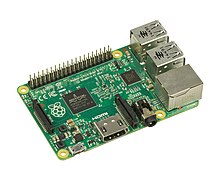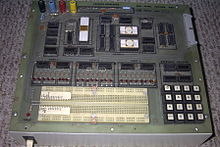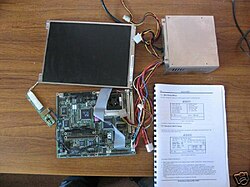Single-board computer
This article has multiple issues. Please help improve it or discuss these issues on the talk page. (Learn how and when to remove these template messages)
|

A single-board computer (SBC) is a complete
Unlike a desktop
A computer-on-module is a type of single-board computer made to plug into a carrier board, baseboard, or backplane for system expansion.[2][3]
History

The first true single-board computer was based on the Intel C8080A, also using Intel's first EPROM, the C1702A. Schematics for the machine, called the "dyna-micro" were published in Radio-Electronics magazine in May 1976. Later that year, production of the system began by E&L Instruments, a Derby, Connecticut based computer manufacturer, which branded the system as the "Mini Micro Designer 1", intending it for use as a programmable microcontroller for prototyping electronic products.[4][5] The MMD-1 was made famous as an example microcomputer in popular 8080 instruction series of the time.[6]
Early SBCs figured heavily in the early history of
As the PC became more prevalent, SBCs decreased in market share due to their low extensibility. The rapid adoption of
Computers began to move back towards fewer boards in the 2000s. As new standards like
The 2010s were defined by rapid and sustained growth in single-board computers, enabled largely by advances in integrated circuit production techniques that made it possible for the first time to include most or all of the core components of a motherboard on a
By the end of the 2010s and the early 2020s, many devices, including smartphones,
Applications

Single board computers were made possible by increasing the density of integrated circuits. A single-board configuration reduces a system's overall cost, by reducing the number of circuit boards required, and by eliminating connectors and bus driver circuits that would otherwise be used. By putting all the functions on one board, a smaller overall system can be obtained, for example, as in notebook computers. Connectors are a frequent source of reliability problems, so a single-board system eliminates these problems.[10]
Single board computers are now commonly defined across two distinct architectures: no slots and slot support.
The term "Single Board Computer" now generally applies to an architecture where the single board computer is plugged into a
Single board computers are most commonly used in industrial situations where they are used in
The primary advantage of an ATX motherboard as compared to an SBC is cost. Motherboards are manufactured by the millions for the consumer and office markets allowing tremendous economies of scale. Single-board computers are a market niche and are manufactured less often and at a higher cost. Motherboards and SBCs now offer similar levels of feature integration meaning that a motherboard failure in either standard will require equivalent replacement
Types, standards
Ranges of single-board computers include Raspberry Pi, BeagleBoard and Nano Pi.[13][14][15]
One common variety of single board computer uses standardized
Some single-board computers have connectors that allow a stack of circuit boards, each containing expansion hardware, to be assembled without a traditional backplane. Examples of stacking SBC form factors include
; these systems are commonly available for use in embedded control systems.Stack-type SBCs often have memory provided on plug-cards such as
Form factors
- AdvancedTCA
- CompactPCI
- Embedded Compact Extended (ECX)
- Mini-ITX
- Multibus
- PC/104
- PICMG
- Pico-ITX
- PXI
- Qseven
- VMEbus
- VPX
- VXI
- 96Boards(CE, EE, EETV and IE)
See also
- Computer on module
- Embedded system
- Motherboard
- Plug computer
- Single-board microcontroller
- System on a chip
- List of open-source computing hardware
References
- ^ "Foundation Strategy 2016–2018" (PDF). Raspberry Pi. Raspberry Pi Foundation. pp. 3–5. Archived (PDF) from the original on 9 June 2016. Retrieved 26 November 2016.
- ^ "COM – Based SBCs: The Superior Architecture for Small Form Factor Embedded Systems" (PDF). Diamond Systems Corp. Archived (PDF) from the original on 29 December 2016. Retrieved 27 December 2016.
- ^ "Implementing High Performance Embedded Computing Hardware" (PDF). Trenton Systems, Inc. September 1, 2016. pp. 13–15. Archived (PDF) from the original on 26 November 2016. Retrieved 26 November 2016.
- ^ "E&L Instruments | OpenCorporates". opencorporates.com. Retrieved 2023-03-06.
- ^ "Mini-Micro Designer 1 (MMD1)". www.decodesystems.com. Retrieved 2023-03-06.
- ^ "Virginia Information". www.bugbookcomputermuseum.com. Retrieved 2023-03-06.
- ^ "Ampro Little Board". Archived from the original on 2020-02-07. Retrieved 2020-09-05.
- ^ Cawley, Christian (2019-12-10). "19 Awesome Uses for a Raspberry Pi". MUO. Retrieved 2023-03-06.
- ^ "What You Should Know About Right to Repair". Wirecutter: Reviews for the Real World. 2021-07-15. Retrieved 2023-03-06.
- ISBN 0-7897-1743-3pp. 50-51
- ^ "Single Board Computer Peripherals". Newmicros. Archived from the original on June 28, 2017. Retrieved July 7, 2017.
- ^ "A UHF RFID Printed Circuit Board Solution". Magicstrap. January 2012. p. 4. Archived from the original on 26 November 2016. Retrieved 26 November 2016.
- ^ updated, Brian Westover last (2021-05-27). "Raspberry Pi 4 Model B review". Tom's Guide. Retrieved 2023-04-29.
- ^ Manager, Content (2023-01-29). "BeagleBone Black Review". ElectronicsHacks. Retrieved 2023-04-29.
- ^ Alderson, Alex. "FriendlyELEC introduces new NanoPi R6C single-board computer for US$89". Notebookcheck. Retrieved 2023-04-29.
